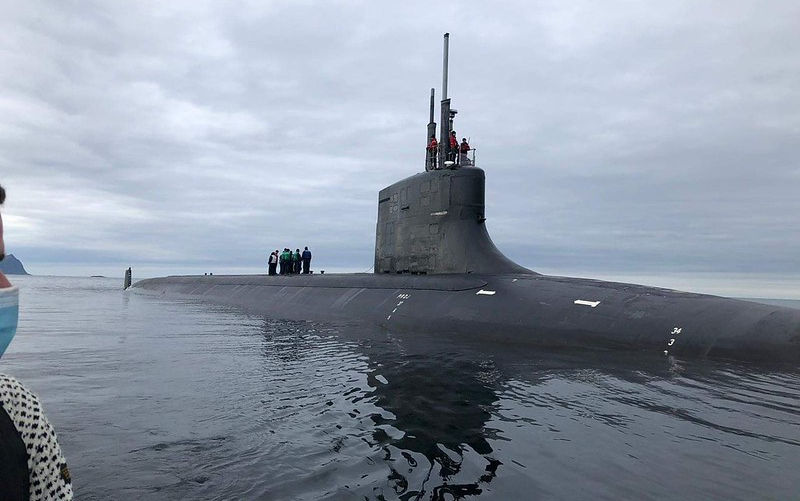SSNs for the RAN: A response to Brian Toohey
February 26, 2023
Brian Toohey (Pearls and Irritations, 14 February 2023) makes a number of criticisms of the recent four-part series on national security by Michael Keating and myself that was published in Pearls and Irritations earlier this month. He contends that we have made assertions that should not go unchallenged, particularly in regard to our support for the acquisition of nuclear-powered submarines (SSNs) by the RAN.
In Part 4 of our series, we stated that the primary role for Australian submarines is anti-submarine warfare (ASW) and that the most prospective location in which to interdict another submarine is proximate to its base. In peacetime our submarines undertake intelligence gathering, surveillance and reconnaissance operations (ISR) in the same location. In many situations they operate under a theatre ASW agreement with the US submarine force and no doubt benefit substantially from access to the Integrated Undersea Surveillance System (IUSS). Although subject to continuous development over a very long period of time, this is the same network that has been used by NATO ASW forces in the Atlantic theatre since the 1950s.
Tooheys first criticism is that China could regard such behaviour as an aggressive action by Australia. This would be true if our submarines failed to remain in international waters, in which case it would be within Chinas rights to take steps to evict them. But Australian submarines constitute only a small part of what is likely to be a major surveillance effort. As well as submarines, a number of different allied assets are employed in the ISR task. Surface ships with towed array sonar systems (SURTASS), crewed partly by civilians, plough the waters of the South China Sea searching for submarines. Maritime patrol aircraft undertake the same role, as do helicopters and satellites. This is all permitted under international law. China is entitled to do the same thing.
Next, Toohey suggests that our submarines do not need to pursue this task because Japan, South Korea and Singapore all have high-quality submarines closer to China. If we do need to send an Australian conventional submarine to China, he says, we can do so from bases in northern Australia.
Toohey is unlikely to gain any traction on the first point. No government will contract out Australias top-secret intelligence gathering and surveillance operations to other countries with which we do not have an alliance and are not members of the Five Eyes group. On the second point, there are no submarine bases in northern Australia. The US operated submarines out of Fremantle during World War II but were unable to establish a base further north. With a big tidal range and many navigational hazards, as well as being prone to cyclones, the littoral around northern Australia is a difficult operating environment for submarines.
We do not challenge Tooheys main point that contemporary conventional submarines embody technological advances, including modern batteries and air-independent propulsion (AIP), that increase their dived endurance and make them stealthier than the Collins-class. As Toohey says, the latest Japanese Taigei-class submarines, equipped with Lithium-Ion batteries, will exhibit a considerable improvement in performance when they enter service next year.
The problem is that while the Taigei-class will likely be very good at what it does, Japanese submarines have a different operational requirement to RAN boats. Their area of operations is on their doorstep and their patrols generally last around two weeks, making it possible for them to operate dived throughout without needing to re-charge their batteries. By contrast, Australian submarines undertake 70-day operations, with around half of them spent in transit. If equipped with modern batteries they would still have to recharge them while on patrol, although less frequently than today. For various technical reasons, however, transit times are unlikely to be affected. Even with a fleet of 12 modern conventional submarines, therefore, it is unlikely that Australia could deploy more than one submarine on station at long range at any time.
Toohey exaggerates the performance benefits of both modern batteries and AIP. He says the Taigei class can go as fast as a nuclear submarine. Yet Dr Google gives Taigei a top speed of 20 knots, the same as a Collins-class submarine. In both cases these are burst speeds that are not sustainable for very long; the limiting factor is likely to be the main motor as much as the battery. By contrast, American and British SSNs have a top speed of around 30 knots, 50 per cent higher than Collins or Taigei, and one that can be sustained virtually at the commanding officers pleasure.
Tooheys claim that submarines equipped with fuel cell AIP can operate for four to six weeks before going near the surface is different to my understanding. AIP can be used to enable a European submarine operating in the cold waters of the Baltic to remain dived throughout its two- or even, perhaps, three-week operation. But this can be considerably reduced, to perhaps seven to ten days, in the warm waters where RAN submarines patrol. Extensive evaluations of AIP systems on the long operations undertaken by RAN submarines also suggest that the net benefit of AIP would be marginal at best. The relatively short-lived stealth benefits on patrol may be negated by the effect of additional weight on the submarines performance over the course of lengthy transits.
In light of this discussion, therefore, we can find no evidence to support Tooheys extravagant claim that advances in technology are making conventional submarines even more formidable than nuclear ones, which are easier to detect. The US, Britain and France only operate nuclear-powered submarine forces and show no signs of changing their policy. While it may have been true thirty years ago that conventional boats had advantages over nuclear-powered submarines in terms of their acoustic signature, this is simply not the case today. SSNs have benefited from major innovations, including electric drive, pump-jet propulsors and better noise insulation, that have made them as difficult to detect as conventional submarines.
SSNs provide strategic and operational advantages that no conventional submarine can match. Because of their effectiveness in both ASW and anti-surface ship warfare, they would be of critical importance for the delivery of the governments sensible new military strategy of enforcing maritime denial at a long distance from Australia.
In terms of ASW, conventional submarines are useful for lurking in choke points and other covert locations, detecting a submarine and reporting it to the network controller. Other assets, including SSNs, are then generally cued onto the target to track it. In particular, an SSN is much more effective in tracking another nuclear-powered submarine.
The distances involved in waters far distant from Australia are vast. Speed is of the essence in terms of interdicting an adversarys surface fleet once it has been detected. With a sustainable speed 50 per cent higher than a surface task force and four times greater than a conventional submarine, SSNs are ideally suited to this role. They also have a deterrent effect. In the Falklands war, after one old warship was sunk by a British SSN with heavy loss of life, the Argentine Armada withdrew to its base and thereafter never left it.
Aside from Tooheys criticisms, however, the AUKUS SSN program faces some challenges. With the first SSN unlikely to enter service until the 2040s, one critical issue is the need for new conventional submarines, and not just to bridge the capability gap in Australian defences when the Collins-class retires.
Approximately three times the present number of trained submariners will be needed to populate the nuclear submarines. Without new conventional boats or joint crewing of Australian SSNs with foreign sailors, which categorically would not constitute a sovereign capability, it is well-nigh impossible to see how to generate a growing pipeline of submariners as the number of RAN submarines at sea declines to nothing. A program for constructing an evolved version of the Collins-class, incorporating advances in stealth technologies, would not just address the capability gap and provide at sea training for submariners. It would also assist in developing the experienced shipyard workforce required to build the very complex SSNs.
The Defence Minister, however, recently ruled out building new conventional submarines. Hugh White is not alone in wondering how long it will take him to realise that this is simply not a credible position. One problem may be that Defence is not supporting a new conventional submarine build. In the past they have seen an intention to acquire eight Oberon submarines drop to six and the same with eight Collins-class. It is possible that, with new conventional submarines coming off the line, a future government would cut the planned purchase of at least eight SSNs to six, which would be below critical mass, or even fewer. But attempting to second guess future governments is a very dangerous game for officials to play. We might end up with no submarines at all.
Finally, Michael Keating and I see benefit in the acquisition of a sovereign SSN capability not primarily to provide support to our allies but rather to enable Australia to become substantially more self-reliant in our own defence. We live in a region that has become increasingly dangerous in this century and we can have little certainty of what our strategic situation will look like in 20- or 30-years time. Australia may, for example, face new threats from countries with which we currently enjoy friendly relations. We do not know whether the US will still be a force to be reckoned with in the Indo-Pacific by the mid-century. Indeed, in emphasising the importance of the Defence Structure Review and the need for increased spending on defence, Hugh White wrote last week of the big brutal fact that the DSR almost certainly evades: we will face the dangers of the decades ahead alone.
Read Brian Toohey’s article:

